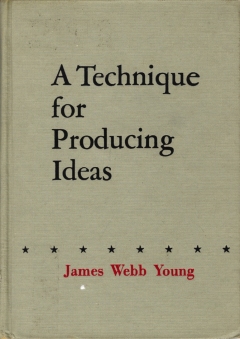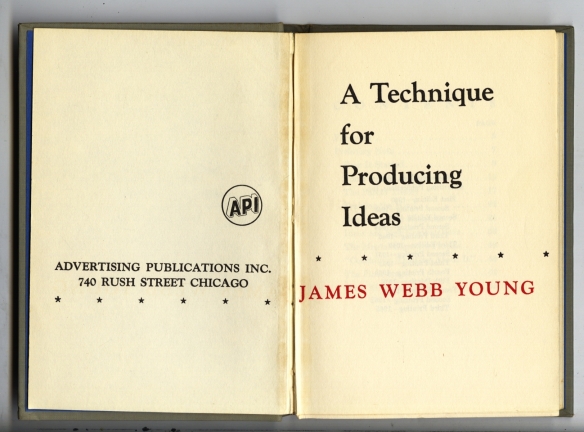----
A Technique for Producing Ideas //
Picture It 
Creativity talk is hot right now. There are lots of speeches, workshops and books dedicated to it. I've taught a couple of creativity workshops myself, centered around Design Thinking which is most famously espoused by IDEO and Stanford University. But creativity itself isn't new.
Recently, I came across the attractive little book, A Technique for Producing Ideas at a library sale, written by James Webb Young, back in 1940. It looked so simple, short, and sweet, that I bought it for use as a prop in my office – an amusing relic of simpler times. Much later, I took the time to read it, but with the confidence that the subject is both too complicated and too mysterious to be codified in such a teeny text. However, it didn't work out that way.
James Young Webb was an advertising guy and his book grew out of a speech he gave to students at the School of Business at the University of Chicago. It was such a hit, he turned it into a book and it's been in print ever since.
James Webb Young's focus here is on the steps of coming up with new ideas that solve problems. Problem-solving is in illustrator's primary job. It's not drawing or painting or self expression that makes us valuable, it's the creation of visual communication concepts. Drawing, painting and expression serve the ideas.
So, to take a tiny book and make it even smaller, here are the general points:
Webb starts off by describing creative people as speculative. Refering to Italian sociologist (Vilfredo) Pareto's theory: to be speculative is to be preoccupied with new combinations of things. It's Webb's belief that new ideas really boil down to new combinations of old elements. And, the key to creative success is the ability to find valuable relationships in those new combinations.
Therefore, the job is not where to look for ideas, but how to look for ideas.

Five Steps for Producing Ideas
(These are my titles, with Webb's quotes in italics and my explanations below them.)
Research
Gather raw materials- both the materials of your immediate problem and the materials which come from a constant enrichment of your store of general knowledge.
Inform yourself for the task at hand as much as possible, but also be a student of the world around you, so as to connect effectively to the broader population.
Work/Play
Work over the new materials in your mind.
Sketch, write, brainstorm for a new idea. Combine things to create new ideas. Work to create possibilities further in the process.
Don't Work
The incubation stage, where you let something besides the conscious mind do the synthesis.
Take a break. Sleep on it. Get away from the problem at hand.
A-Ha!
The actual birth of the Idea- the "Eureka! I have it!" stage.
That's when an idea pops into your head at a surprising time – of in the "don't work" phase. Or when you realize that you have some pretty good ideas worth revisiting upon getting back to work.
Fix It
The final shaping and development of the idea to practical usefulness.
After getting the idea, you need to get the idea right. Shaping the proper solution takes an extra level of thinking- even with the best ideas.
Webb admits that steps are seemingly simple. He writes, "…the formula is so simple to state that few who read it really believe in it." And, "while it's simple to state, it actually requires the hardest kind of intellectual work to follow, so that not all that accept it to use it… "thus, I broadcast this formula with no real fear of glutting the market (with great thinkers)"
As for me, I recommend both the steps and the book – available online in different forms.
It's a practical book for the practical art of producing ideas.
----
Shared via
my feedly reader 

No comments:
Post a Comment